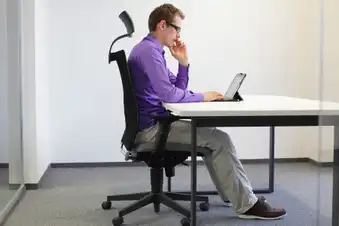How to Manage Ankylosing Spondylitis at Work

Adjust Your Chair
Ankylosing spondylitis (AS) can make your back stiff and achy. And it can feel even worse if you sit for a long time. Lower the seat of your desk chair so your thighs are at a right angle when you sit. It’s best if you can plant your feet firmly on the floor. And make sure your chair’s back supports your spine while you sit.

Move Around Often
If you have a desk job, walk around for 5 to 10 minutes after every hour you sit. If you’re on a conference call, put the phone on speaker and stand up and stretch. Need to ask a co-worker a question? Walk over and chat in person.

Check Your Posture
Try to sit, stand, or walk with your spine straight, not slumped. This can help you have less AS pain in your spine. Check your posture in a full-length mirror at home. If you tend to slouch in meetings, ask a co-worker to let you know. Come up with a signal they can give you to remind you to sit up straight.

Support Your Back
If your chair doesn’t offer enough support, roll up a towel and put it between your lower back and the chair. A small pillow can also help, or you might try a special lumbar-support pillow.

Keep Things Close at Hand
Arrange your desk so you don’t have to reach for anything you use often. Make sure you can keep your back against your chair while you type, use your mouse, or talk on the phone, for example. And when you make a call, hold the receiver up to your ear or use a headset. Don't cradle it between your ear and your shoulder.

Hold Your Hands Level
If you have to type a lot, let your hands hover above the keyboard. Resting your wrists on your desk can put your hands at an awkward angle. To help keep them in the right position, you can use a cushion called a wrist mat to support your wrists as you type. But don't lean on or push into it. That can put pressure on your wrists.

Set Your Monitor Height
If you have to look down at your computer screen, that can make your neck or back pain worse. Move your monitor so its top is at your eye level. Your keyboard and mouse should be even with or just slightly below your forearms. Put risers under your desk’s legs if they’re too low, or put your laptop on a stack of big books.

Stay Out of Rush Hour
Stress is a major cause of work disability for people who have AS. If your daily commute stresses you out, ask for flexible hours so you can come in earlier or later. If you can do your job away from the office, see if you can work from home some days.

Stock Up on Healthy Snacks
What you eat and drink can affect how you feel. For example, starchy foods like chips or crackers may make AS symptoms worse. Keep healthy, low-starch snacks like nuts in your desk drawer instead. If you have a fridge at work, store some fresh fruit or veggies for snack attacks.

Work Your Muscles
Sneak a few minutes of exercise or stretching into your schedule each day. Even moving for a few minutes can ease stiff joints and muscles. You can do quick stretches right at your desk: Turn your upper body at your waist while your bottom stays put. Put your hand on your jaw while you turn your head to each side. Try a yoga or tai chi class at lunchtime.

Carry Boxes Carefully
With some jobs, it can be easy to hurt your back at work. If you have to pick up a heavy box, for example, squat and lift it -- don’t stoop or bend at your waist. And try not to twist your back or lean sideways when you lift. Hold the box close to your body as you carry it. Look straight ahead as you walk so you don’t trip. If something is too heavy, ask someone to help you with it.

Find Tools to Help
You’ll have days when your pain or other symptoms feel worse. Find ways to deal with those ups and downs that work for you. For example, you might ask for thicker pens that are easier to hold or for grab bars to be installed in the restrooms.

Set Limits
Be realistic about what you can do so you don’t burn out or tire yourself out. Strike a balance when it comes to what you do each day, and on lighter days, take care of things you’ve been putting off so you can check them off the list.

Talk to Your Supervisor
By law, your employer may have to make reasonable changes to your schedule or work area to help you do your job. Come up with a plan, and talk to your supervisor about it. If you need to take some time off to deal with a flare or surgery, let your boss and human resources staff know. Your employee handbook will detail your company’s sick leave policies.
Show Sources
Photo Credits:
1) endopack / Getty Images
2) gpointstudio / Getty Images
3) Wavebreakmedia / Getty Images
4) nelik / Getty Images
5) jacoblund / Getty Images
6) Creatas / Getty Images
7) YakobchukOlena / Getty Images
8) ddisq / iStock / Getty Images
9) NatashaPhoto / Getty Images
10) AH86 / Getty Images
11) IAN HOOTON/SCIENCE PHOTO LIBRARY
12) manfredxy / Getty Images
13) Jacob Ammentorp Lund / Getty Images
14) shironosov / Getty Images
SOURCES:
MayoClinic.org: “Ankylosing spondylitis.”
National Health Service: “Back pain at work.”
American Occupational Therapy Association: “Healthy Computing.”
LifeHack.org: “15 Office Design Tricks That Will Increase Your Productivity at Work.”
Arthritis Research UK: “Stand up at work.”
Spondylitis Association of America: “Exercise and Posture.”
UCLA Health: “Ergonomics for prolonged sitting.”
Chiropractic and Manual Therapies: “The effect of a lumbar support pillow on lumbar posture and comfort during a long seated task.”
Canadian Centre for Occupational Health and Safety: “Computer Mouse – common problems from use.”
Arthritis Research UK: “What can I do to help myself at work?”
Annals of the Rheumatic Diseases: “Employment perspectives of patients with ankylosing spondylitis.”
Georgetown University Health Policy Institute: “Workers Affected by Chronic Conditions: How Can Workplace Policies and Programs Help?”
Rheumatology International: “Raised incidence of ankylosing spondylitis among Inuit populations could be due to high HLA-B27 association and starch consumption.”
Spondylitis Association of America: “Diet’s Effect on Spondylitis Symptoms.”
Arthritis Research UK: “Work and Ankylosing Spondylitis (AS).”
Arthritis Research UK: “Exercises for Ankylosing Spondylitis (AS).”
Arthritis New South Wales: “Ankylosing Spondylitis Exercises With Michael Slater.”
National Ankylosing Spondylitis Society: “AS and Fatigue.”
National Ankylosing Spondylitis Society: “Top tips for managing your AS.”
National Health Service UK: “Safe lifting tips.”
UW Medicine Orthopedics and Sports Medicine: “Ankylosing Spondylitis.”
Arthritis Foundation: “Self-Help Arthritis Devices.”
Arthritis Foundation: “Workplace Rights With Arthritis.”
Center for Advancing Health: “How Do You Tell Your Employer That You Are Sick?”